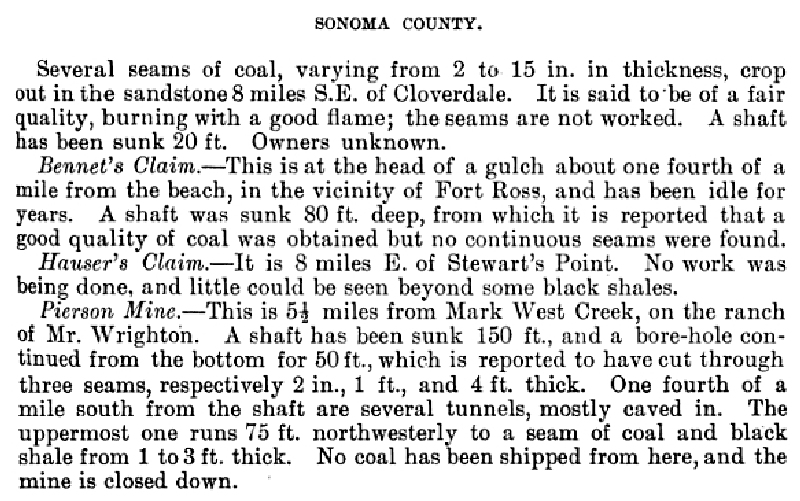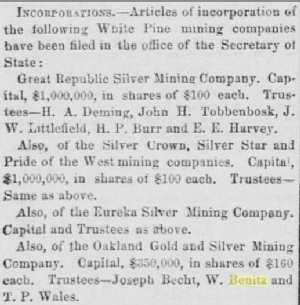 |
William Benitz | Page last modified: |
 |
William Benitz | Page last modified: |
We believe Wilhelm himself did little actual prospecting, digging, or mining for gold. Per family anecdotes he collected gold from a river – which agrees with Kashaya oral history, quoted next. Neither we nor the Kashaya historians know precisely where nor when. However, it was very likely from the same river, or nearby, where gold was first discovered (the American River, at Sutter’s Mill near Coloma), and probably within weeks of the discovery (24 January, 1848), well before the flood of prospectors who arrived during the Gold Rush of 1849.
According to Herman James, Kashaya oral historian:
“When he had lived here for a while, [the boss] led his Indians off to dig gold at a place in the south. It took three weeks to go there… they dipped the gold out from under the water, poured it out in a certain place and gathered it up. Then having loaded it all into sacks, they lifted it up onto a mule and returned. It took more than three weeks to come back – tired out. Then they set it down – set the gold down at Metini. Having done so, they spread it out to take the dampness off. Then the boss had the Indians guard it, knowing the Indians wouldn’t steal it – they wouldn’t put even one nugget in their pockets. They just guarded it.”
As quoted in a paper by R.L. Oswalt, 1964.
Herman James’ account matches Benitz family anecdotes on two points: one mule load of ore, and spreading it on the ground to dry (at Fort Ross) with Indians to guard it.
The following account by Allen James, a more recent Kashaya historian, provides other details. The six mules likely includes those carrying equipment and supplies. Note that “1849” most likely should be “1848”.
“Not mentioned by Benitz in his letters, or by his family, was his time spent in the gold mines, probably in the summer of 1849. It is referred to by Allen James in stories of his Kashaya ancestors, four of whom helped Benitz and John Meyer (sic) with their six mules CAJ:1 at the mines and probably did any necessary digging. Also, Frederick Hugal apparently sold the men his German Rancho shares when he met them carrying gold dust in Sonoma City on their way home from the mines.”
from: “The Old Salt Point Township”, Vol. II, by Lynn Hay Rudy, pg.7.
(CAJ:1 “Life story of Allen James, Chief of the Pomos, 1904-1984”, by A.M. Connor).
Son Frank J. Benitz wrote the following in his diary on 4 July, 1876 (William died 27 June):
“Mother presented me to-day, with a little gold-dust that father had, it is some of the first gold-dust discovered in California and found at Sutters Mill; Also a piece of Quartz coming from Fraser river, and another piece of quartz that father found personally in the mines.”
William, in a letter (dated October, 7, 1863) to his brother Thaddaeus in Germany, wrote “Copper has been found as near as 4 miles from my house,...” – He had already contracted with miners to prospect a limited area on Rancho de Muniz - see the first contract in the table below.
We found four contracts, at the Sonoma County Recorder’s Office, in which William sold the mining rights to areas of Rancho de Muniz. The contracts were made in 1863 and 1865. Apparently the first two contracts (made in 1863) failed to deliver and were replaced by the second two (made in 1865). Two of the four contracts had time clauses – they were void if mining had not begun or the mines had been inactive for six months.
We have not discovered more about mining on Rancho de Muniz and assume none of the contracts panned-out, i.e. nothing of sufficient value was discovered to warrant mining before William sold Muniz and Fort Ross in 1867.
| Date | End-Date | Book | Mining Co. | Mineral Rights Granted | Results |
|---|---|---|---|---|---|
| 23-Jul-63 | (not specified) | Book of Agreements B (pg. 49) (Repeated on B (pg.53) ) |
“The Santa Ottilia Copper and Silver Mining Co.”: W.W.Hudspeth & partners, J.M. Ward & partners, Moses Davis & partners. |
3/4 rights to a mineral ledge situated on the boundary of the Muniz grant, going NW-SE 2,000 feet (WBz rights extended to 6,000 ft.) | Unknown |
| 21-Nov-63 | 10 years (Contract voided if mine not worked for 6 months) |
Book of Agreements B (pg. 62-63) |
Trustees of the Fort Ross Coal Mine Co. (A. Morstadt, C. Poehlman, C. Tempel - all of Petaluma) |
9/10 proceeds for only right to prospect for coal in the southern half of Rancho Mooney (Muniz), for 10 years. | Likely voided at 6 months |
| 03-Apr-65 | 10 years + another 10 if desired |
Book of Agreements B (pg.152-153) |
F.W. Shattuck J.L. Bonds (of Petaluma) |
9/10 proceeds for only right to prospect for coal, petroleum, and all minerals in the northern half of Rancho Mooney (Muniz). | Unknown |
| 03-Apr-65 | 10 years + another 10 if desired (Contract voided if mine not worked for 6 months) |
Book of Agreements B (pg. 155-157) |
Trustees of the Fort Ross Mining Co. (Conrad Tempel, Thos. Schlosser, J.L. Rugg) |
9/10 mineral rights to coal, petroleum, and other minerals in southern half of Rancho de Mooney (Muniz). | Likely voided at 6 months |
Newspaper Articles: |
||
|
Please also see |

Abandoned Mine near Fort Ross |
Per his letters to his brother Thaddaeus, William invested in mining companies while at Fort Ross (1845-1867). From the newspaper article below, we know he continued investing in mining companies while living in Oakland (1867-1874). We assume he sold all his investments shortly before leaving for Argentina end of July, 1874. Following his death (27 June, 1876), there is no mention in his children’s diaries of any remaining investments in the U.S.A.
1853 - June 27: “I have invested $36.000.- which give me $500.- a month.”
1863 - January 18: “Louis and Adolphus Benitz are also at the mines of Washoo [Washoe Co., Nevada], but I dont get much news from them. Perhaps I will go there myself next spring to buy shares in a few mines.”:
1863 - October 7: “I have a share in 6 different mines. These mines cost a lot before one can extract good ore. Several years might go by for all these mines to work properly, ...”
Newspaper Articles: |
||
|
Please also see |

W. Benitz a trustee of the |
© Peter Benitz (Benitz Family)